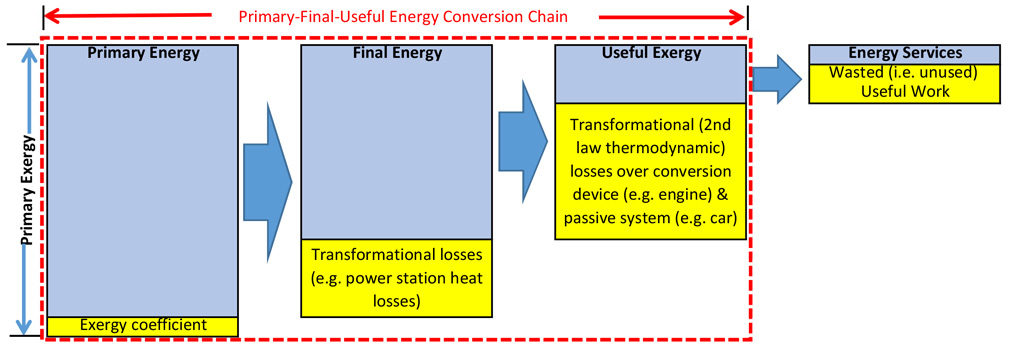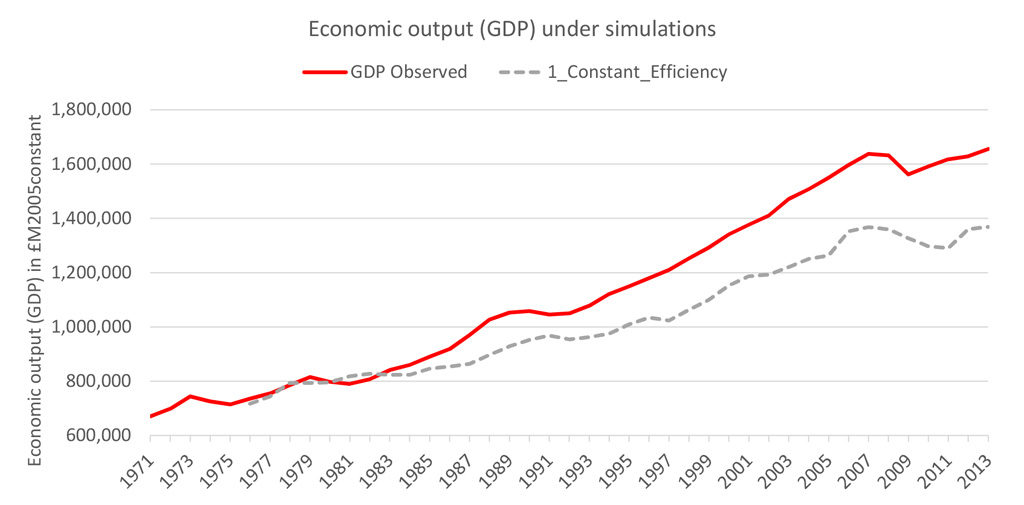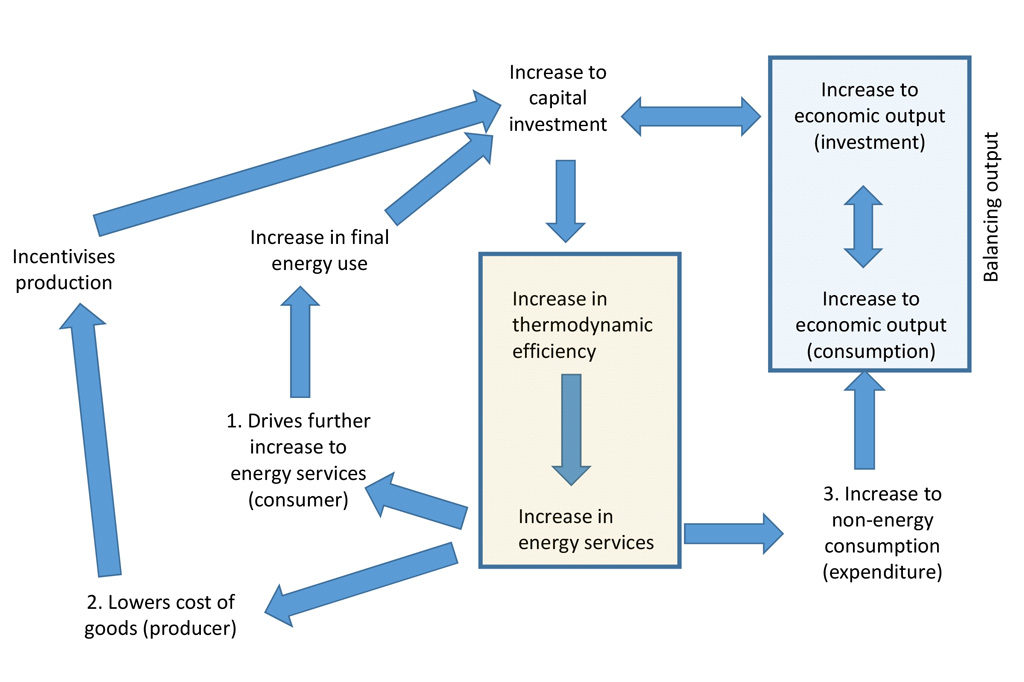
Guest post: Energy efficiency contributed 25% of UK economic growth since 1971
Multiple Authors
02.22.19Multiple Authors
22.02.2019 | 11:03amDr Paul Brockway is a university academic fellow at the University of Leeds; Dr Marco Sakai is lecturer at the University of York; Prof John Barrett is chair in energy and climate policy at the University of Leeds; and Prof Peter Taylor is chair in sustainable energy systems at the University of Leeds.
Improving energy efficiency is seen as a key strategy for meeting global climate goals under the Paris Agreement.
Yet the historical record shows global energy use has been closely coupled to economic output, with the two generally increasing in lockstep. This is a concern, given the need to limit growth in energy use even as global GDP is expected to continue rising.
Moreover, the precise nature of interactions between the economy and energy use are poorly understood, beyond their past close coupling. One little-studied aspect of this conundrum is the last stage of energy use – for example, the useful energy contained in hot water or lighting.
Many current models fail to properly account for the conversion of energy inputs, such as coal, into this useful energy stage. Including this process in our models might help us to better understand the coupling between energy use and GDP – and what we might do in response.
In a new study in the journal Energies, we try to accurately model this chain of successive energy conversions to explore the energy-economy relationship in the UK. We find that gains in energy efficiency have contributed a quarter of all growth in UK GDP over the period 1971-2013.
In short, energy has a much larger role in economic growth than conventional wisdom supposes.
Model efficiency
To more accurately investigate the relationship between energy and economic growth, we developed the UK MAcroeconometric Resource COnsumption (MARCO-UK) model. This represents the UK economy over the period 1971-2013 and includes interactions between over 50 socioeconomic variables including GDP, investment, labour, prices, wages and disposable income.
The major novelty in MARCO-UK is that it includes a thermodynamic representation of energy flows through the economy – from primary energy sources, such as coal, through to final energy carriers, such as electricity, and then to what is known as “useful energy”.
As its name suggests, useful energy is the portion of energy that is available to be put to use – turning on a lightbulb, for example, converts final energy into useful energy to produce light. Overall, our thermodynamic approach means we can simulate not only the quantity of energy, but also its quality for performing different tasks.
The last of these stages – “useful energy” – is important, but is rarely included in models. Useful energy is as close to the energy services that we need – the ability to read a book at night, for example – as it is possible to measure in energy terms.
Research suggests that it is this useful energy stage that has the closest links to the economy, rather than the earlier primary and final energy stages. In other words, the economy needs energy services, such as cold fridges, not primary energy, such as coal.
Crucially, each step in the conversion from primary energy through to energy services entails thermodynamic losses, shown in the chart, below. For example, much of the primary energy in coal is wasted as heat when it is burnt for electricity generation (“transformational losses”, below).

Thermodynamic losses (yellow) as energy (blue) is converted from primary energy into energy services, via intermediate steps in the chain of final and useful energy. Source: Sakai, M. et al. (2018).
Another key difference in MARCO-UK is that it places energy flows and energy efficiency at the core of the modelling framework. This means that changes to energy use or efficiency in our model have broad impacts on the rest of the economic system, whereas conventional models often assume the only effects come via energy prices.
Efficiency driving growth
Taken together, these features of our model mean we have a greater ability to study the impact of energy efficiency gains on economic growth in the UK. And our results show a much larger role for energy efficiency than is commonly supposed, emerging as a key driver of rising GDP.
The red line in the chart below shows how UK GDP increased from around £0.6tn in 1971 to £1.6tn in 2013. The dashed purple line shows that UK GDP would have grown by only 75% of the actual £1.0tn increase, without the gains in energy efficiency that have taken place.

Actual UK economic output (GDP, red line) compared to a simulation with constant energy efficiency. Source: Sakai, M. et al. (2018).
Our results may also help explain the UK’s much-discussed ‘“productivity puzzle”, where labour output per worker has declined and efforts to reverse this have been unsuccessful. The reason may simply be down to a shrinking role for labour in the economy, against an increasingly important role for energy productivity – in other words, energy efficiency improvements.
There are a range of processes behind the efficiency-led economic growth that we found. These processes are shown in the schematic, below.
First, improved efficiency means that consumers can buy the energy services they need at lower cost. This frees up money that they can use to buy additional energy services thus expanding overall demand.
This process is known as the “rebound effect”, where some or all of the energy savings due to efficiency are taken back by additional energy use. For example, savings from more efficient lightbulbs could be lost by turning up the thermostat.

Schematic representation of the ‘efficiency-led growth engine’ mechanism. The numbered processes show routes by which higher efficiency can drive faster economic growth. Source: Sakai, M. et al. (2018).
Second, a similar effect for producers increases their productivity in terms of their rate of output for a given investment. This can stimulate increased production of goods via additional investment in productive capital, such as new machinery. For example, a car factory might upgrade its production line using savings from the more efficient operation it allows, making more vehicles as a result.
Third is a consumerism effect, where higher and higher levels of consumption occur. In this case, the consumption of more energy services (via energy efficiency gains) increases expenditure on other goods and services. This increases economic output, stimulating further increases to capital investment and energy consumption.
Note that each of these processes is driven by additional demand for “energy services”. This is the very last stage of the energy flow chart shown earlier – reflecting the amount of energy actually being used (or wasted) by consumers. This additional demand can lead to rising primary energy use, but it does not have to if efficiency improves too.
Decoupling challenge
Our results show that as much as 25% of the increase in the UK’s GDP since 1971 has been driven by energy efficiency gains. This has global implications, given the many similarities between the UK and other advanced economies.
This finding suggests that the tight coupling between global energy use and GDP can be explained because of – not in spite of – decades of energy efficiency investment. In other words, investments in energy efficiency are a key driver of economic growth.
Our findings also hold important lessons for policymakers. They suggest that improving energy efficiency has benefits far beyond climate policy, given that the delivery of increased energy services can improve aspects of society, such as livelihoods and wellbeing.
More problematically, our results show that a crucial part of global climate policy is likely to be less effective than thought at delivering reductions in energy use. If we want to “decouple” energy use from GDP growth in pursuit of global climate goals, then several options are possible in response.
The first is to design energy-efficiency policies that are less likely to trigger rebound effects and more likely to lead to decoupling. This can be done by combining efficiency policies with approaches that increase the price of energy, such as energy or carbon taxes.
A second response is to consider how we can deliver energy services – such as warmth, travel or lighting – in ways that reduce primary energy demand. Alternatively, we could focus on reducing demand for energy services, via a “sufficiency” strategy that encourages a more equitable distribution of resources.
A third option is to place greater emphasis on alternative policy levers, such as increasing the deployment of renewable energy technologies. This seems sensible if improved energy efficiency might not deliver energy and carbon savings as well as we hoped.
Finally, we need to continue improving our understanding of how energy contributes to the economic system, in order to better inform policy in the longer-term.
Sakai, M. et al. (2018) Thermodynamic efficiency gains and their role as a key ‘engine of economic growth’, energies, doi: 10.3390/en12010110
-
Guest post: Energy efficiency contributed 25% of UK economic growth since 1971

